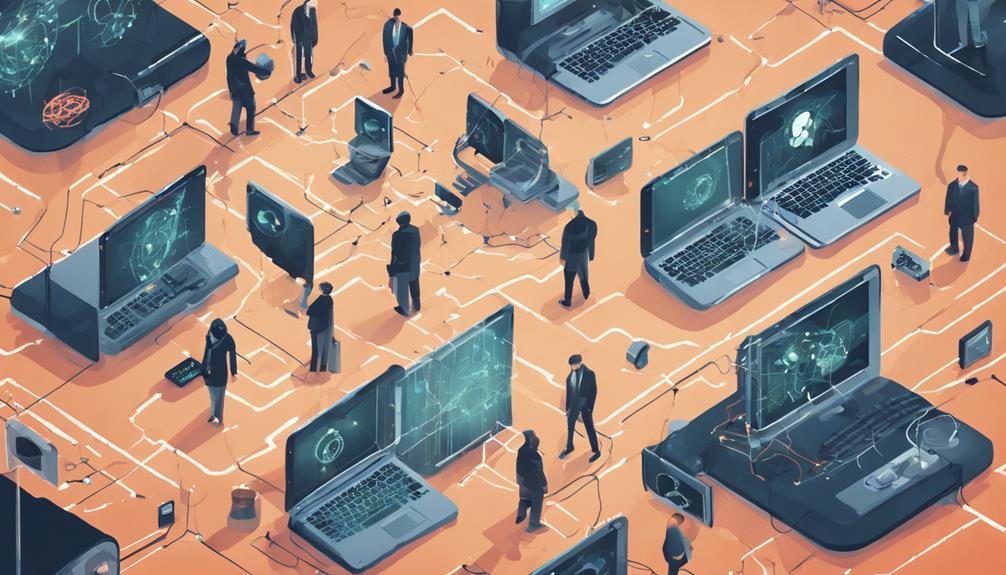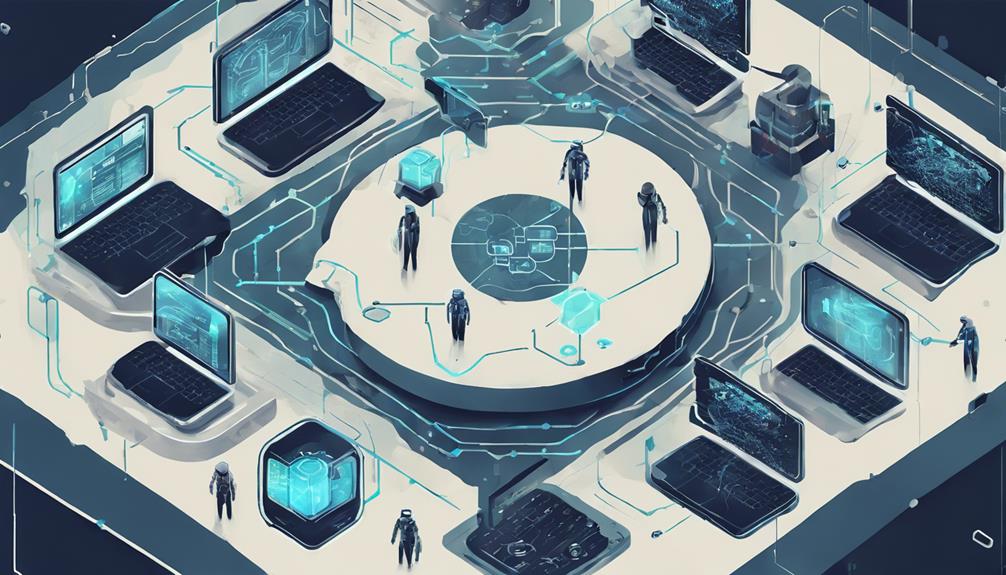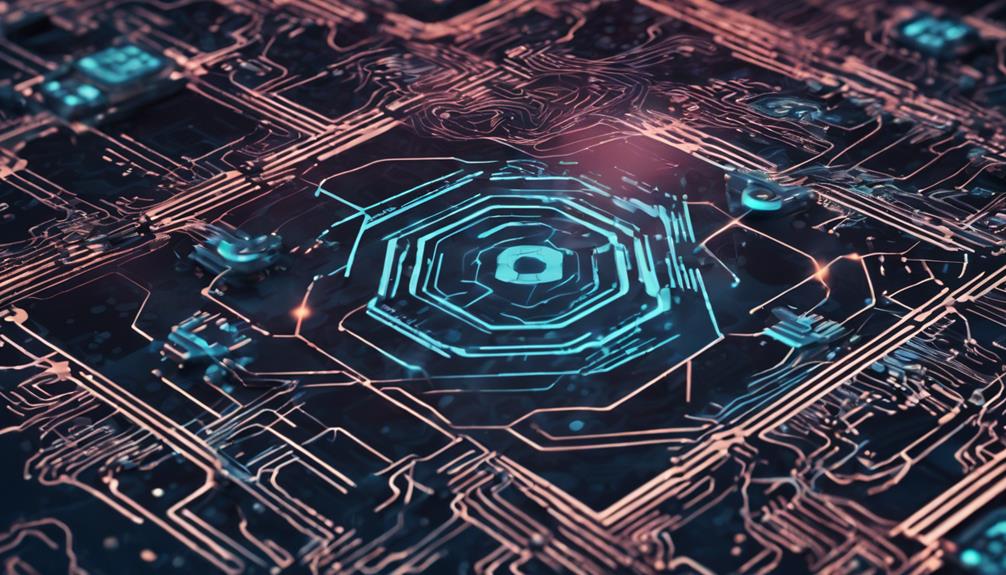AI is shaping the future of cybersecurity by bolstering defenses against cyber threats. It plays a pivotal role in swiftly detecting malicious activities and fortifying networks. With AI, proactive defense strategies become possible, enabling early threat detection and simulation of attack scenarios to enhance security practices. Predictions indicate a significant rise in AI adoption by global organizations, decreasing response times to threats and revolutionizing cyber defense methods. Despite challenges like ethical considerations and data privacy, AI's automation and analysis capabilities greatly improve threat detection and response efficacy. Embrace AI to stay ahead in the evolving cybersecurity landscape.
Key Takeaways
- AI enhances threat detection capabilities for proactive cybersecurity measures.
- Predictive analytics powered by AI anticipate up to 95% of cybersecurity breaches.
- AI integration revolutionizes cybersecurity practices and defense mechanisms.
- Global AI cybersecurity market expected to reach $46.3 billion by 2027.
- AI adoption decreases response times to cyber threats by 40%.
AI's Role in Cyber Defense
In the domain of cybersecurity, AI plays a pivotal role in bolstering defense mechanisms against evolving cyber threats. Machine learning algorithms, a subset of AI, empower systems to detect and respond to malicious activities swiftly and accurately. By utilizing AI systems, organizations can proactively defend their networks and data against a wide range of cyberattacks.
One key advantage of AI for cybersecurity is its capability for early detection. AI-driven tools can analyze vast amounts of data in real-time, enabling the identification of anomalies and potential threats before they escalate into full-blown security breaches.
Additionally, Generative AI technology can simulate various attack scenarios, allowing cybersecurity professionals to better prepare and fortify their defenses.
Benefits of AI in Cybersecurity

AI brings a multitude of benefits to cybersecurity. This includes enhanced threat detection capabilities that enable organizations to identify and respond to potential risks more effectively.
Additionally, AI plays an important role in improving incident response times. This allows for quicker mitigation of security breaches and minimizing potential damage.
Enhanced Threat Detection
By automating the analysis of vast datasets in real-time, AI tools greatly enhance threat detection and response capabilities in cybersecurity. These AI-driven systems leverage machine learning algorithms to continuously analyze data, identifying patterns and anomalies that may indicate potential threats. This proactive approach enables cybersecurity teams to detect and mitigate risks more effectively, ultimately strengthening the overall security posture of organizations.
To better illustrate the benefits of AI in threat detection, consider the following comparison table:
| Traditional Methods | AI-Driven Approach |
|---|---|
| Manual data analysis | Automated data analysis |
| Limited scalability | Scalable to handle vast datasets |
| Slower response time | Improved response time |
| Human errors possible | Reduced human errors |
Embracing AI in cybersecurity not only streamlines threat detection processes but also enhances response times, ultimately fortifying defenses against evolving cyber threats. However, it is important to emphasize the responsible use of AI to ensure its ethical application in safeguarding digital assets.
Improved Incident Response
Enhancing incident response capabilities, AI technology in cybersecurity greatly improves organizations' readiness to swiftly address and mitigate threats. By leveraging AI-driven security measures, companies can enhance their cybersecurity incident response in various ways:
- Faster Response Times: AI in cybersecurity improves incident response times by up to 12%, enabling organizations to react promptly to potential threats.
- Reduced Dwell Time: Implementation of AI-driven security measures decreases dwell time by 11%, ensuring threats are detected and mitigated swiftly.
- Cost Savings: AI enables organizations to reduce breach detection costs by as much as 15%, resulting in significant financial savings in cybersecurity operations.
- Tangible Benefits: PetSmart's $12 million cost savings through AI-powered fraud detection exemplifies the concrete advantages of AI in incident response, showcasing its potential impact on enhancing cybersecurity operations.
The growing prioritization of AI for threat detection by executives further emphasizes the pivotal role AI plays in improving cybersecurity incident response capabilities.
Adaptive Defense Strategies
The implementation of adaptive defense strategies empowered by AI technology in cybersecurity demonstrates a proactive approach towards enhancing overall security resilience. AI in cybersecurity enables organizations to leverage advanced machine learning algorithms for real-time threat detection, enabling swift response to threats.
By analyzing anomalies and patterns in data, AI enhances security posture by identifying potential cyber threats more efficiently than traditional methods. Additionally, AI automation streamlines security operations, increasing operational efficiency and effectiveness.
The rising adoption of AI-driven security orchestration and response platforms further strengthens defenses, allowing for faster and more accurate threat identification and response mechanisms. As enterprises increasingly invest in AI technologies to bolster their defense strategies, the trend towards adaptive defense strategies fortified by AI continues to grow, showcasing the significant benefits AI brings to the cybersecurity landscape.
Predictions for AI Integration

Predictions indicate a notable shift towards increased integration of AI technology in the field of cybersecurity. This transformation is set to revolutionize how organizations defend against cyber threats and bolster their security measures. Here are some key predictions for AI integration in cybersecurity:
- Global Adoption: By 2024, an estimated 90% of global organizations will embrace AI-driven cybersecurity tools to enhance their defense capabilities significantly.
- Reduced Response Times: AI integration is projected to decrease response times to cyber threats by an impressive 40%, allowing for quicker identification and mitigation of security incidents.
- Market Growth: The AI cybersecurity market is expected to soar to $46.3 billion by 2027, illustrating the rapid expansion and adoption of AI technologies in the cybersecurity landscape.
- Enhanced Predictive Analytics: Predictive analytics powered by AI will enable organizations to anticipate up to 95% of cybersecurity breaches before they manifest, providing proactive security measures.
These predictions underscore the immense potential of AI in transforming cybersecurity practices, improving response efficiency, and fortifying defense mechanisms against evolving threats.
Challenges With AI Adoption

Implementing AI in cybersecurity may present hurdles, including resistance to change within organizations. Overcoming these challenges requires fostering a culture that embraces innovation and invests in upskilling employees to leverage AI effectively.
AI Implementation Hurdles
Despite significant advancements in AI technology, organizations continue to face substantial challenges when adopting AI for cybersecurity purposes. Several hurdles hinder the seamless implementation of AI in cybersecurity:
- AI implementation challenges: Integrating AI systems into existing cybersecurity frameworks can be complex and resource-intensive, requiring specialized skills and expertise.
- Ethical considerations: Ensuring the ethical use of AI in cybersecurity is paramount to prevent misuse and maintain trust with stakeholders.
- Data privacy concerns: Safeguarding sensitive data processed by AI algorithms is critical to mitigate privacy risks and comply with regulations.
- Security risks and adversarial attacks: AI systems themselves can become targets for malicious attacks, highlighting the need for robust defense mechanisms to protect against potential vulnerabilities.
Organizations must focus on overcoming these obstacles through responsible deployment practices, proactive risk management, and continuous monitoring to harness the full potential of AI in enhancing cybersecurity defenses.
Resistance to Change
Facing resistance from cybersecurity analysts overwhelmed by their workload, organizations encounter challenges in adopting AI solutions for enhanced cybersecurity measures. Despite the potential benefits of AI-driven security analytics, concerns about adversarial attacks and the ethical use of AI technologies hinder widespread adoption.
However, the industry is moving towards embracing AI-powered autonomous security operations to address these obstacles. By automating routine tasks and augmenting human capabilities, AI can alleviate the burden on cybersecurity analysts and improve overall efficiency.
To overcome resistance to change, organizations must prioritize training and education on the benefits of AI solutions in cybersecurity. Demonstrating the positive impact of AI technologies in threat detection, incident response, and vulnerability management can help build trust and confidence in these tools.
Moreover, emphasizing the importance of ethical considerations in AI implementation can mitigate fears and promote acceptance within the cybersecurity community. By fostering a culture of continuous learning and adaptation, organizations can navigate the challenges of AI adoption and pave the way for a more secure digital landscape.
Enhancing Threat Detection

With the advancement of AI technology, organizations are greatly enhancing their threat detection capabilities in cybersecurity. AI accelerates threat detection by analyzing vast amounts of data in real-time, allowing for the swift identification of potential threats.
Machine learning algorithms embedded within AI systems play an essential role in detecting anomalies and patterns that could signify cyber threats, providing organizations with a proactive defense mechanism. By leveraging AI-driven tools, businesses can greatly improve their threat detection and response capabilities, ensuring a robust security posture.
- AI processes data in real-time, enabling rapid threat detection.
- Machine learning algorithms identify anomalies and patterns indicative of cyber threats.
- AI automation streamlines security tasks, enhancing efficiency and response times.
- Security orchestration platforms powered by AI offer proactive cybersecurity measures to organizations.
Future of Autonomous Security Operations

The evolution of autonomous security operations, driven by AI technologies, is poised to revolutionize the landscape of cybersecurity in the coming years. AI-driven security analytics and machine learning algorithms enable real-time data analysis, enhancing threat detection capabilities within autonomous security operations. These advancements empower organizations to proactively identify and respond to cyber threats efficiently.
Security orchestration plays a vital role in the future of autonomous security operations, automating tasks and streamlining processes to improve overall security posture. However, it is essential to prioritize the ethical use of AI to make certain that these technologies are deployed responsibly and in alignment with regulatory guidelines.
As the cybersecurity industry continues to evolve, embracing autonomous security operations powered by AI will be paramount in mitigating the ever-growing complexity of cyber threats. By leveraging AI-driven tools and platforms, organizations can stay ahead of malicious actors and protect their sensitive data effectively.
Leveraging AI for Data Analysis

AI's utilization in data analysis within cybersecurity operations enhances efficiency and precision through automated processes and machine learning algorithms. Leveraging AI for data analysis in cybersecurity brings numerous benefits:
- Automated Threat Detection: AI-driven machine learning algorithms can swiftly identify patterns and anomalies in data, aiding in the early detection of potential security threats.
- Proactive Security Measures: By enabling real-time analysis of vast amounts of data, AI empowers organizations to proactively strengthen their security posture and preemptively mitigate risks.
- Enhanced Defense Strategies: AI applications in data analysis streamline security operations, allowing for the development of robust defense strategies that adapt to evolving cyber threats.
- Improved Response Capabilities: AI-driven tools not only enhance threat detection but also optimize response capabilities, enabling cybersecurity teams to act swiftly and decisively in the face of a security incident.
Incorporating AI into data analysis processes is pivotal for organizations looking to bolster their cybersecurity defenses and stay ahead of sophisticated cyber threats.
Strengthening Cyber Defenses

Moreover, markedly advanced technology and strategic methodologies are essential for fortifying cybersecurity defenses against evolving threats. AI plays a pivotal role in enhancing these defenses by automating threat detection and response processes, ensuring real-time monitoring and mitigation of cyber threats. Machine learning algorithms embedded in AI systems greatly boost accuracy in identifying and neutralizing potential risks.
By predicting attack vectors and efficiently prioritizing risks based on likelihood and consequences, AI empowers cybersecurity professionals to proactively defend against malicious activities.
To effectively strengthen cyber defenses, it is imperative that AI systems remain flexible, secure, and regularly updated to thwart any attempts at manipulation by hackers. Additionally, fostering collaboration between AI technology and human expertise is key to constructing robust and scalable cybersecurity defenses. By leveraging the unique strengths of both AI and human capabilities, organizations can establish a formidable defense mechanism capable of combating diverse cyber threats with precision and agility.
Impact of AI on Response Times

With the integration of AI in cybersecurity operations, response times experience a significant enhancement, leading to more efficient and effective mitigation of cyber threats. AI-powered systems play a pivotal role in revolutionizing how organizations respond to security incidents, offering a range of benefits that shape the future of cybersecurity strategies. Here are some key impacts of AI on response times:
- Detection Cost Reduction: AI reduces breach detection costs by up to 15%, enhancing overall cost-effectiveness in cybersecurity operations.
- Dwell Time Reduction: AI integration decreases dwell time by 11%, enabling quicker identification and response to potential threats.
- Financial Savings: Companies like PetSmart saved $12 million through AI-powered fraud detection mechanisms, showcasing the financial benefits of AI implementation.
- Executive Priority: 51% of executives prioritize AI for enhanced threat detection capabilities, highlighting the growing recognition of AI's importance in cybersecurity response strategies.
These statistics underscore the critical role AI plays in improving response times and efficiency within cybersecurity operations, shaping a more secure digital landscape for the future.
Evolving AI Technologies in Cybersecurity

AI technologies are revolutionizing cybersecurity through advanced threat detection, anomaly detection, and incident response capabilities.
By utilizing machine learning and deep learning models, cybersecurity experts can identify attack precursors and enhance overall threat intelligence.
Investing in AI-driven cybersecurity solutions enables organizations to stay ahead of cyber threats and bolster their defense mechanisms effectively.
AI in Threat Detection
Amid the rapidly evolving landscape of cybersecurity, the integration of advanced AI technologies has greatly enhanced threat detection capabilities. AI, particularly through machine learning algorithms, plays a pivotal role in analyzing vast amounts of data for anomaly detection in cybersecurity.
Here are four key ways AI is transforming threat detection:
- Improved Response Times: AI-driven tools enable swift responses to cyber threats, markedly reducing dwell time and enhancing overall cybersecurity posture.
- Predictive Models: By leveraging historical data analysis, AI assists in predicting and preventing cyber attacks before they occur, providing proactive defense mechanisms.
- Heightened Awareness of Bad Actors: As cyber threats evolve, AI helps in identifying and combating bad actors, with 85% of security professionals noting an increase in attacks orchestrated by malicious entities utilizing generative AI.
- Enhanced Cybersecurity Measures: The utilization of AI in threat detection signifies a proactive approach to cybersecurity, offering advanced capabilities to stay ahead of evolving threats from bad actors.
AI for Anomaly Detection
In the field of cybersecurity, the evolution of AI technologies has revolutionized the detection and mitigation of potential security threats. Particularly in anomaly detection, AI leverages machine learning algorithms to identify unusual patterns in network traffic. This enables the swift detection of security breaches and abnormal user behavior.
These AI-driven solutions continuously learn from data, enhancing threat detection accuracy while minimizing false positives.
AI for Incident Response
The integration of advanced AI technologies into cybersecurity practices is reshaping the landscape of incident response strategies. AI for incident response leverages machine learning to analyze vast amounts of data in real-time, enabling swift identification and mitigation of security threats.
Through automation, tasks that previously required manual intervention can now be executed efficiently, enhancing the overall cybersecurity posture of organizations. Security orchestration platforms powered by AI streamline incident response workflows, ensuring that responses are not only prompt but also effective in addressing evolving cyber threats.
Additionally, the utilization of predictive analytics in AI tools enables proactive incident response by forecasting potential attack vectors, allowing cybersecurity teams to stay one step ahead of malicious actors. By reducing response times, minimizing dwell time, and implementing proactive measures, AI-driven incident response is instrumental in fortifying defenses against cyber threats and ensuring the resilience of digital infrastructures.
Frequently Asked Questions
Can AI Predict Cyber Attacks?
Yes, AI can predict cyber attacks by leveraging historical data and identifying patterns that signify potential threats. Machine learning algorithms aid in detecting attack precursors and vulnerabilities before exploitation, enhancing cybersecurity defenses through proactive threat mitigation.
Why Artificial Intelligence Is the Future?
In the rapidly evolving landscape of cybersecurity, artificial intelligence emerges as the future due to its unparalleled capacity for threat detection, mitigation, and response. This transformative technology promises enhanced security measures and proactive defense strategies.
How AI Is Improving Security?
AI is improving security by automating threat detection, response, and mitigation processes. Machine learning algorithms analyze real-time data to detect anomalies and patterns. Predictive analytics powered by AI forecast cyber threats, reducing breach detection costs and response times.
What Is the Scope of AI in Cyber Security?
In the dynamic domain of cybersecurity, AI's scope is vast, encompassing predictive analytics, behavioral analysis, and automated threat mitigation strategies. Its prowess lies in accelerating threat detection, enhancing anomaly identification, and streamlining security operations.
Conclusion
To sum up, AI's increasing role in cybersecurity is like a guiding light in the darkness, illuminating potential threats and empowering organizations to defend against cyberattacks more effectively.
As technology continues to evolve, integrating AI into cybersecurity strategies will be essential for staying ahead of malicious actors.
By leveraging the power of AI for threat detection, data analysis, and response times, organizations can strengthen their cyber defenses and protect sensitive information more efficiently.









